Effects of Cold Post-Fermentation Process on Microbial Diversity and Biogenic Amines in Protease-Assisted Fermented sufu
Abstract
1. Introduction
2. Materials and Methods
2.1. Materials and Reagents
2.2. Enzyme-Assisted Low-Temperature Fermentation of sufu
2.3. Determination of Physical and Chemical Properties of sufu
2.4. Microbiological Diversity Analysis of sufu
2.5. Methods of Statistical Analysis
3. Results and Discussion
3.1. Changes in the Physicochemical Properties of sufu
3.2. Changes in the Biogenic Amine Content of sufu
3.3. Correlation Analysis Between Different Physicochemical Properties and BA
3.4. The Impact of LTEF20 on Bacterial Diversity at Different Fermentation Stages
3.5. Roles of Microbial Diversity in Influencing Physicochemical Properties and Biogenic Amines
4. Conclusions
Author Contributions
Funding
Institutional Review Board Statement
Informed Consent Statement
Data Availability Statement
Conflicts of Interest
References
- Han, B.-Z.; Rombouts, F.M.; Nout, M.J.R. A Chinese Fermented Soybean Food. Int. J. Food Microbiol. 2001, 65, 1–10. [Google Scholar] [CrossRef] [PubMed]
- Li, X.; He, Y.; Yang, W.; Mu, D.; Zhang, M.; Dai, Y.; Zheng, Z.; Jiang, S.; Wu, X. Comparative Analysis of the Microbial Community and Nutritional Quality of Sufu. Food Sci. Nutr. 2021, 9, 4117–4126. [Google Scholar] [CrossRef] [PubMed]
- Cao, Z.-H.; Green-Johnson, J.M.; Buckley, N.D.; Lin, Q.-Y. Bioactivity of Soy-Based Fermented Foods: A Review. Biotechnol. Adv. 2019, 37, 223–238. [Google Scholar] [CrossRef] [PubMed]
- Wang, X.; Wang, C.; Hu, F.; Yu, M.; Zhu, X.; Wu, D.; Jiang, S.; Tian, J.; Chang, P. Dynamic Monitoring and Correlation Analysis of Flavour Quality and Bacterial Community during Sufu Fermentation. Int. J. Food Sci. Technol. 2023, 58, 5037–5048. [Google Scholar] [CrossRef]
- Cai, H.; Dumba, T.; Sheng, Y.; Li, J.; Lu, Q.; Liu, C.; Cai, C.; Feng, F.; Zhao, M. Microbial Diversity and Chemical Property Analyses of Sufu Products with Different Producing Regions and Dressing Flavors. LWT 2021, 144, 111245. [Google Scholar] [CrossRef]
- Kang, J.Y.; Lee, M.; Song, J.H.; Choi, E.J.; Kim, D.U.; Lim, S.K.; Kim, N.; Chang, J.Y. Lactic Acid Bacteria Strains Used as Starters for Kimchi Fermentation Protect the Disruption of Tight Junctions in the Caco-2 Cell Monolayer Model. J. Microbiol. Biotechnol. 2022, 32, 1583–1588. [Google Scholar] [CrossRef]
- Cai, H.; Zhang, T.; Zhang, Q.; Luo, J.; Cai, C.; Mao, J. Microbial Diversity and Chemical Analysis of the Starters Used in Traditional Chinese Sweet Rice Wine. Food Microbiol. 2018, 73, 319–326. [Google Scholar] [CrossRef]
- Chen, Y.; Zhou, X.; Zhan, J.; Yan, B.; Xie, Y.; Zang, J.; Tang, D.; Tu, Y.; Yin, Z. An Insight into the Quality Formation of Egg-White Sufu Based on the Dynamic Changes of Protease Activity, Physicochemical Properties and Texture. Int. J. Gastron. Food Sci. 2024, 35, 100842. [Google Scholar] [CrossRef]
- Yao, H.; Liu, S.; Liu, T.; Ren, D.; Zhou, Z.; Yang, Q.; Mao, J. Microbial-Derived Salt-Tolerant Proteases and Their Applications in High-Salt Traditional Soybean Fermented Foods: A Review. Bioresour. Bioprocess. 2023, 10, 82. [Google Scholar] [CrossRef]
- Ma, Y.; He, F.J.; MacGregor, G.A. High Salt Intake: Independent Risk Factor for Obesity? Hypertension 2015, 66, 843–849. [Google Scholar] [CrossRef]
- Liang, C.; Liu, L.-X.; Liu, J.; Aihaiti, A.; Tang, X.-J.; Liu, Y.-G. New Insights on Low-Temperature Fermentation for Food. Fermentation 2023, 9, 477. [Google Scholar] [CrossRef]
- Verstrepen, K.J.; Derdelinckx, G.; Dufour, J.-P.; Winderickx, J.; Thevelein, J.M.; Pretorius, I.S.; Delvaux, F.R. Flavor-Active Esters: Adding Fruitiness to Beer. J. Biosci. Bioeng. 2003, 96, 110–118. [Google Scholar] [CrossRef] [PubMed]
- Ren, H.; Liu, H.; Endo, H.; Takagi, Y.; Hayashi, T. Anti-Mutagenic and Anti-Oxidative Activities Found in Chinese Traditional Soybean Fermented Products Furu. Food Chem. 2006, 95, 71–76. [Google Scholar] [CrossRef]
- Petruzziello, E.; Blaiotta, G.; Pittari, E.; Piombino, P.; Aponte, M. Isolation and Characterization of Cryotolerant Yeasts from Fiano Di Avellino Grapes Fermented at Low Temperatures. Foods 2023, 12, 526. [Google Scholar] [CrossRef]
- Cai, H.; Zhang, J.; Liu, C.; Le, T.N.; Lu, Y.; Feng, F.; Zhao, M. High-Fat Diet-Induced Decreased Circulating Bile Acids Contribute to Obesity Associated with Gut Microbiota in Mice. Foods 2024, 13, 699. [Google Scholar] [CrossRef]
- Dabadé, D.S.; Jacxsens, L.; Miclotte, L.; Abatih, E.; Devlieghere, F.; De Meulenaer, B. Survey of Multiple Biogenic Amines and Correlation to Microbiological Quality and Free Amino Acids in Foods. Food Control 2021, 120, 107497. [Google Scholar] [CrossRef]
- Liu, X.; Liang, J.; Ma, Y.; Sun, J.; Liu, Y.; Gu, X.; Wang, Y. The Impact of Protein Hydrolysis on Biogenic Amines Production during Sufu Fermentation. Food Control 2022, 140, 109105. [Google Scholar] [CrossRef]
- Jia, W.; Zhang, R.; Shi, L.; Zhang, F.; Chang, J.; Chu, X. Effects of Spices on the Formation of Biogenic Amines during the Fermentation of Dry Fermented Mutton Sausage. Food Chem. 2020, 321, 126723. [Google Scholar] [CrossRef]
- Lin, X.; Tang, Y.; Hu, Y.; Lu, Y.; Sun, Q.; Lv, Y.; Zhang, Q.; Wu, C.; Zhu, M.; He, Q.; et al. Sodium Reduction in Traditional Fermented Foods: Challenges, Strategies, and Perspectives. J. Agric. Food Chem. 2021, 69, 8065–8080. [Google Scholar] [CrossRef]
- Wei, G.; Regenstein, J.M.; Liu, X.; Zhou, P. Comparative Aroma and Taste Profiles of Oil Furu (Soybean Curd) Fermented with Different Mucor Strains. J. Food Sci. 2020, 85, 1642–1650. [Google Scholar] [CrossRef]
- Jiang, X.; Hu, X.; Huang, H.; Tian, J.; Bu, Y.; Huang, D.; Luo, H. Detecting Total Acid Content Quickly and Accurately by Combining Hyperspectral Imaging and an Optimized Algorithm Method. J. Food Process Eng. 2021, 44, e13844. [Google Scholar] [CrossRef]
- Murthy, P.S.; Palakshappa, S.H.; Padela, J.; Kusumoto, K.-I. Amelioration of Cocoa Organoleptics Using a.Oryzae Cysteine Proteases. LWT 2020, 120, 108919. [Google Scholar] [CrossRef]
- Moonga, H.B.; Schoustra, S.E.; Linnemann, A.R.; Van Den Heuvel, J.; Shindano, J.; Smid, E.J. Influence of Fermentation Temperature on Microbial Community Composition and Physicochemical Properties of Mabisi, a Traditionally Fermented Milk. LWT 2021, 136, 110350. [Google Scholar] [CrossRef]
- Xi, X.; Ke, J.; Ma, Y.; Liu, X.; Gu, X.; Wang, Y. Physiochemical and Taste Characteristics of Traditional Chinese Fermented Food Sufu. J. Food Process. Preserv. 2022, 46, e16845. [Google Scholar] [CrossRef]
- Saha Turna, N.; Chung, R.; McIntyre, L. A Review of Biogenic Amines in Fermented Foods: Occurrence and Health Effects. Heliyon 2024, 10, e24501. [Google Scholar] [CrossRef]
- Yin, Y.; Zhang, Z.; Yang, K.; Gu, P.; Liu, S.; Jia, Y.; Zhang, Z.; Wang, T.; Yin, J.; Miao, H. Deeper Insight into the Effect of Salinity on the Relationship of Enzymatic Activity, Microbial Community and Key Metabolic Pathway during the Anaerobic Digestion of High Strength Organic Wastewater. Bioresour. Technol. 2022, 363, 127978. [Google Scholar] [CrossRef]
- Jeon, A.R.; Lee, J.H.; Mah, J.-H. Biogenic Amine Formation and Bacterial Contribution in Cheonggukjang, a Korean Traditional Fermented Soybean Food. LWT 2018, 92, 282–289. [Google Scholar] [CrossRef]
- Sánchez-Pérez, S.; Comas-Basté, O.; Veciana-Nogués, M.T.; Latorre-Moratalla, M.L.; Vidal-Carou, M.C. Low-Histamine Diets: Is the Exclusion of Foods Justified by Their Histamine Content? Nutrients 2021, 13, 1395. [Google Scholar] [CrossRef]
- Li, X.; Zhang, Y.; Ma, X.; Zhang, G.; Hou, H. Effects of a Novel Starter Culture on Quality Improvement and Putrescine, Cadaverine, and Histamine Inhibition of Fermented Shrimp Paste. Foods 2023, 12, 2833. [Google Scholar] [CrossRef]
- Jaworska, G.; Sidor, A.; Pycia, K.; Jaworska-Tomczyk, K.; Surówka, K. Packaging Method and Storage Temperature Affects Microbiological Quality and Content of Biogenic Amines in Agaricus Bisporus Fruiting Bodies. Food Biosci. 2020, 37, 100736. [Google Scholar] [CrossRef]
- Li, B.; Liang, J.; Baniasadi, H.R.; Kurihara, S.; Phillips, M.A.; Michael, A.J. Functional Identification of Bacterial Spermine, Thermospermine, Norspermine, Norspermidine, Spermidine, and N1-Aminopropylagmatine Synthases. J. Biol. Chem. 2024, 300, 107281. [Google Scholar] [CrossRef] [PubMed]
- Yao, M.; Yang, Y.; Fan, J.; Ma, C.; Liu, X.; Wang, Y.; Wang, B.; Sun, Z.; McClements, D.J.; Zhang, J.; et al. Production, Purification, and Functional Properties of Microbial Fibrinolytic Enzymes Produced by Microorganism Obtained from Soy-Based Fermented Foods: Developments and Challenges. Crit. Rev. Food Sci. Nutr. 2024, 64, 3725–3750. [Google Scholar] [CrossRef] [PubMed]
- Yang, L.; Xian, C.; Li, P.; Wang, X.; Song, D.; Zhao, L.; Zhang, C. The Spatio-Temporal Diversity and Succession of Microbial Community and Its Environment Driving Factors during Stacking Fermentation of Maotai-Flavor Baijiu. Food Res. Int. 2023, 169, 112892. [Google Scholar] [CrossRef] [PubMed]
- Liang, T.; Xie, X.; Ma, J.; Wu, L.; Xi, Y.; Zhao, H.; Li, L.; Li, H.; Feng, Y.; Xue, L.; et al. Microbial Communities and Physicochemical Characteristics of Traditional Dajiang and Sufu in North China Revealed by High-Throughput Sequencing of 16S rRNA. Front. Microbiol. 2021, 12, 665243. [Google Scholar] [CrossRef]
- Wang, Z.; Wang, Z.; Ji, L.; Zhang, J.; Zhao, Z.; Zhang, R.; Bai, T.; Hou, B.; Zhang, Y.; Liu, D.; et al. A Review: Microbial Diversity and Function of Fermented Meat Products in China. Front. Microbiol. 2021, 12, 645435. [Google Scholar] [CrossRef]
- Yang, X.; Song, Z.; Zhou, S.; Guo, H.; Geng, B.; Peng, X.; Zhao, G.; Xie, Y. Insights into Functional Microbial Succession during Nitrogen Transformation in an Ectopic Fermentation System. Bioresour. Technol. 2019, 284, 266–275. [Google Scholar] [CrossRef]
- O’Connell, L.M.; Kelleher, P.; Van Rijswijck, I.M.H.; De Waal, P.; Van Peij, N.N.M.E.; Mahony, J.; Van Sinderen, D. Natural Transformation in Gram-Positive Bacteria and Its Biotechnological Relevance to Lactic Acid Bacteria. Annu. Rev. Food Sci. Technol. 2022, 13, 409–431. [Google Scholar] [CrossRef]
- Hosseinpor, H.; Khaledi, A.; Esmaeili, D. The Properties of Nanofiber Scaffolds of Polyurethane-Cinnamomum Zeylanicum against Pathogens of Pseudomonas Aeruginosa and Staphylococcus Aureus. Polym. Bull. 2021, 78, 223–245. [Google Scholar] [CrossRef]
- Liu, X. Effects of Proteases on L-Glutamic Acid Fermentation. Bioengineered 2019, 10, 646–658. [Google Scholar] [CrossRef]
- He, Z.; Chen, H.; Wang, X.; Lin, X.; Ji, C.; Li, S.; Liang, H. Effects of Different Temperatures on Bacterial Diversity and Volatile Flavor Compounds during the Fermentation of Suancai, a Traditional Fermented Vegetable Food from Northeastern China. LWT 2020, 118, 108773. [Google Scholar] [CrossRef]
- Yumeng, S.U.I.; Huiping, W.; Jiaqi, L.I.U.; Baohua, K.; Ligang, Q.I.N.; Qian, C. Biogenic Amine Formation Based on Microbial Diversity in Fermented Foods: A Review. Sci. Technol. Food Ind. 2024, 45, 356–363. [Google Scholar] [CrossRef]
- Wackett, L.P. Pseudomonas in Biotechnology: An Annotated Selection of World Wide Web Sites Relevant to the Topics in Microbial Biotechnology. Microb. Biotechnol. 2022, 15, 1922–1923. [Google Scholar] [CrossRef] [PubMed]
- Zhang, M.; Jiao, T.; Chen, S.; Zhou, W. A Review of Microbial Nitrogen Transformations and Microbiome Engineering for Biological Nitrogen Removal under Salinity Stress. Chemosphere 2023, 341, 139949. [Google Scholar] [CrossRef] [PubMed]

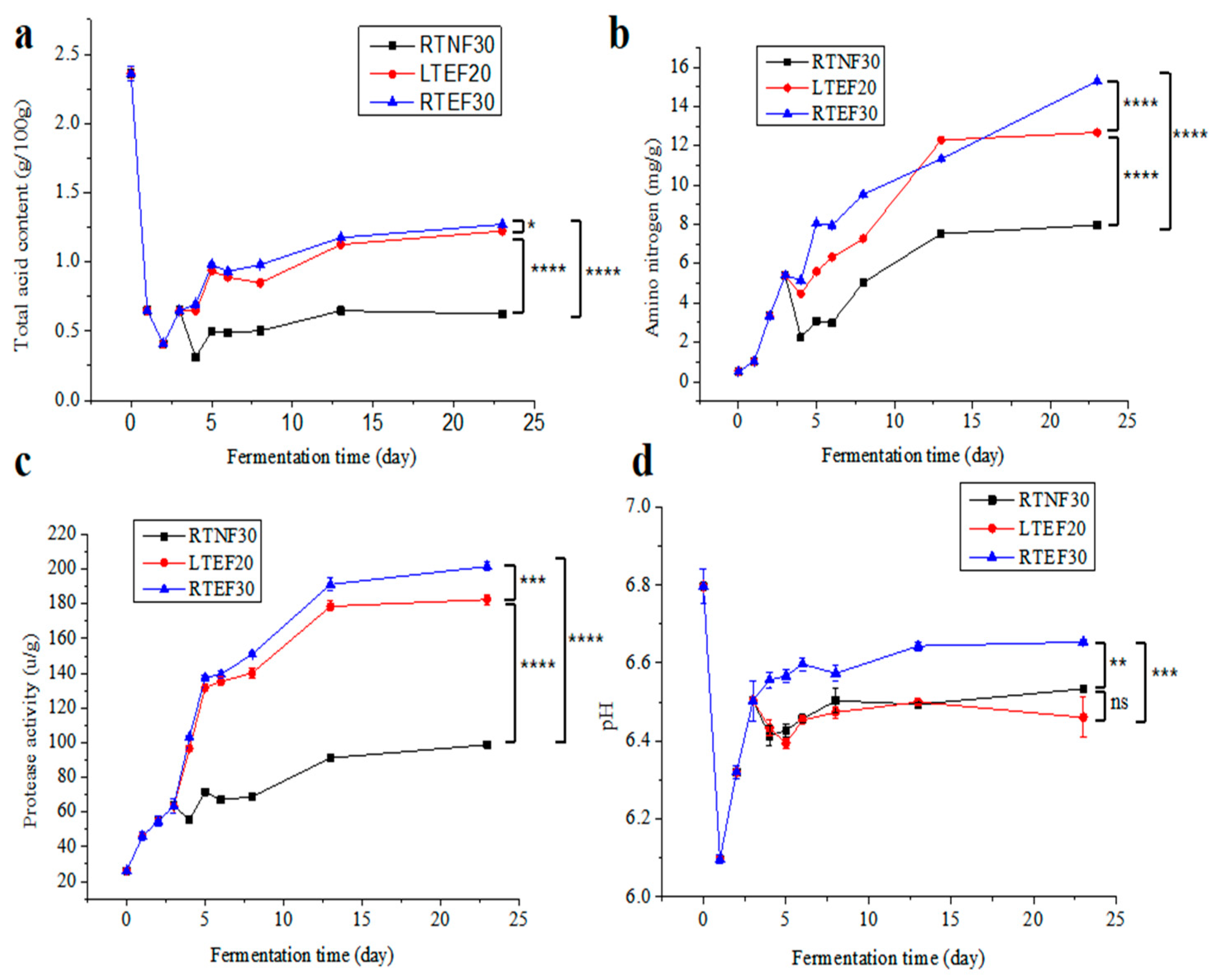
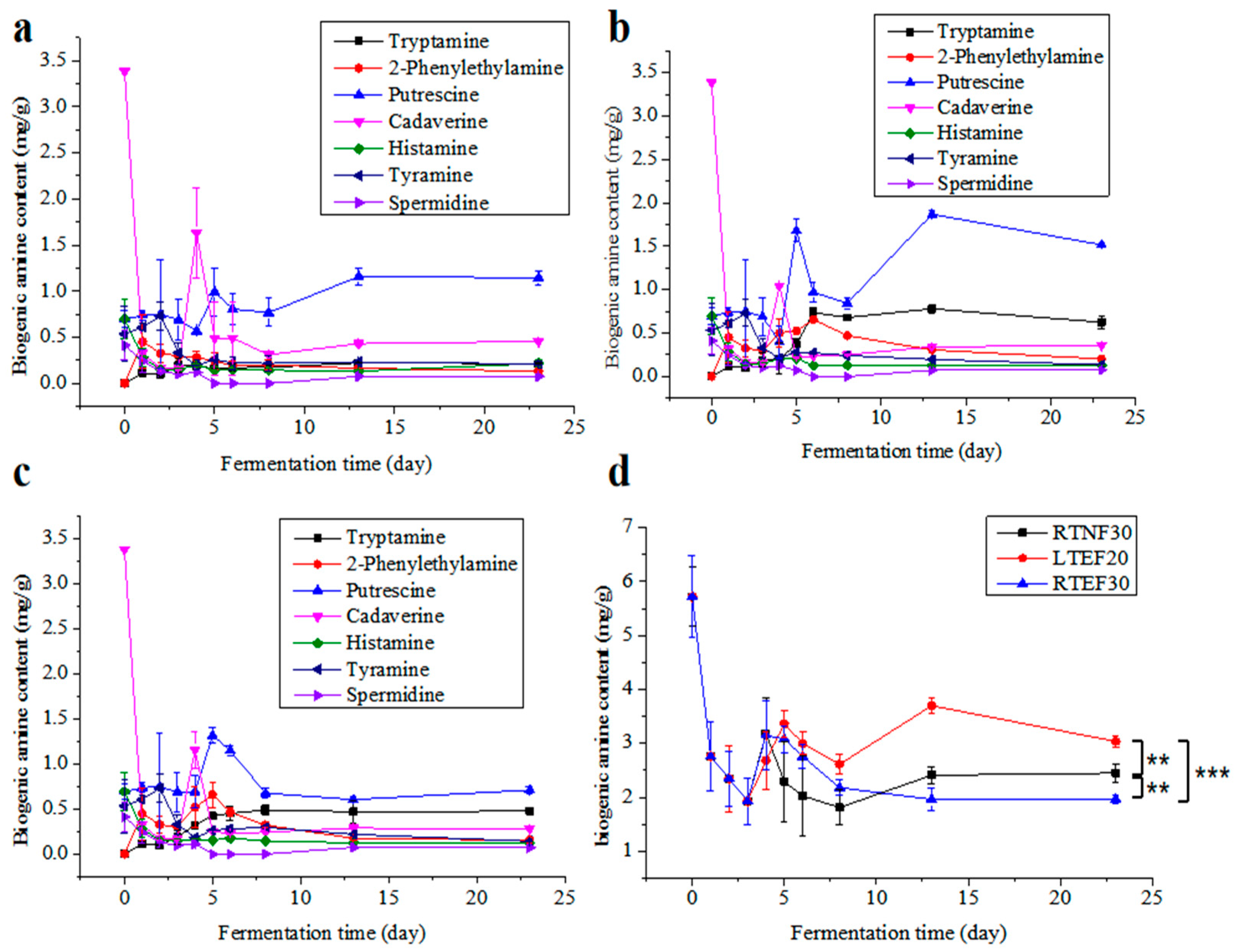
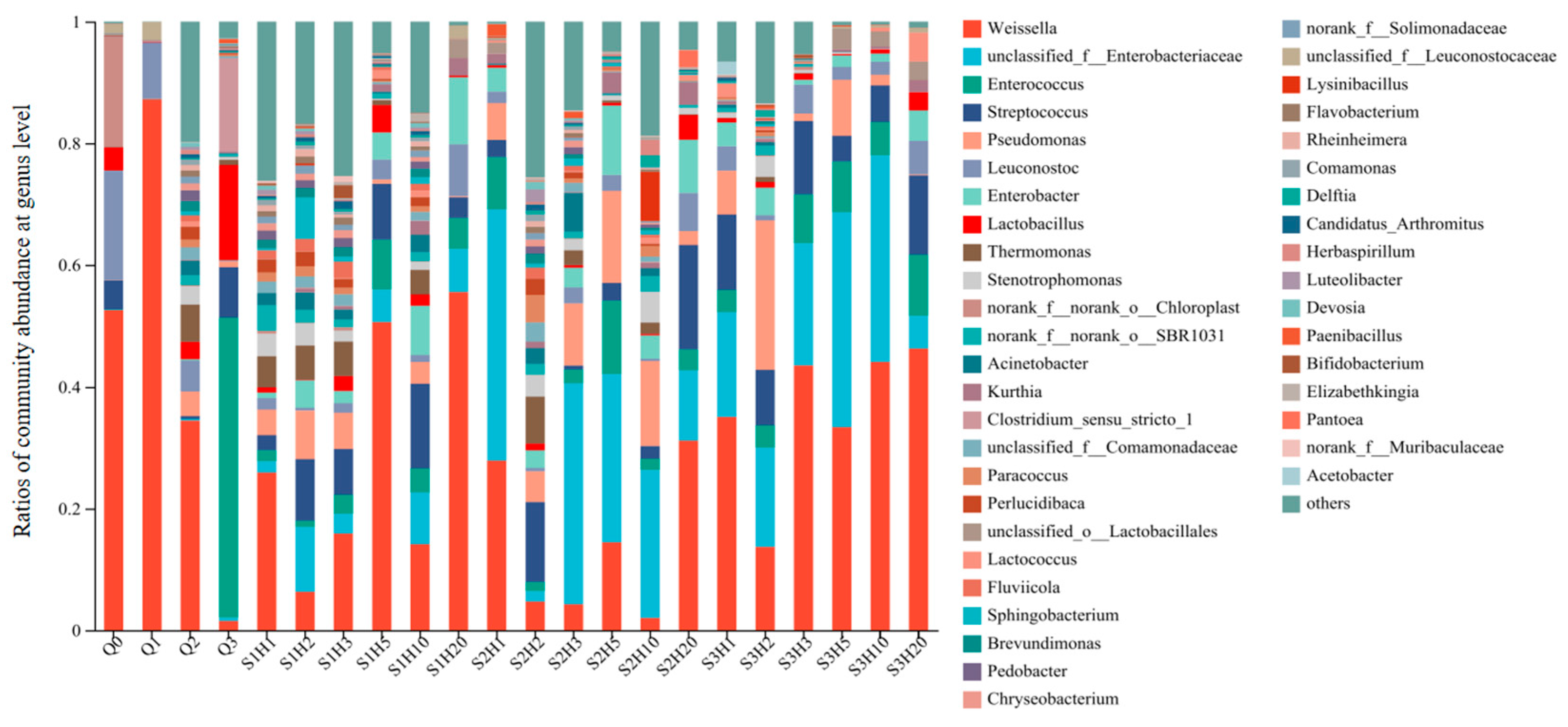
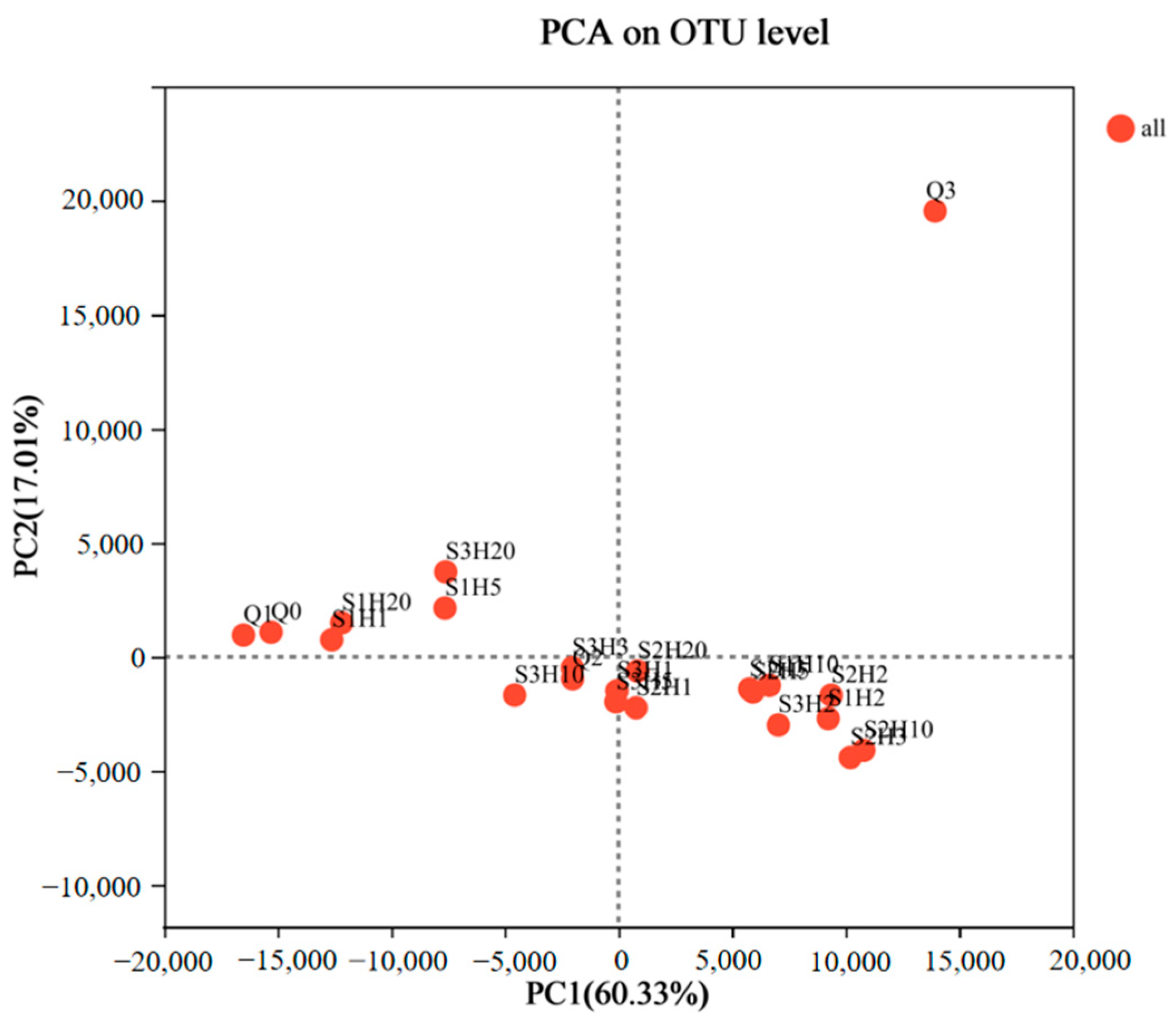
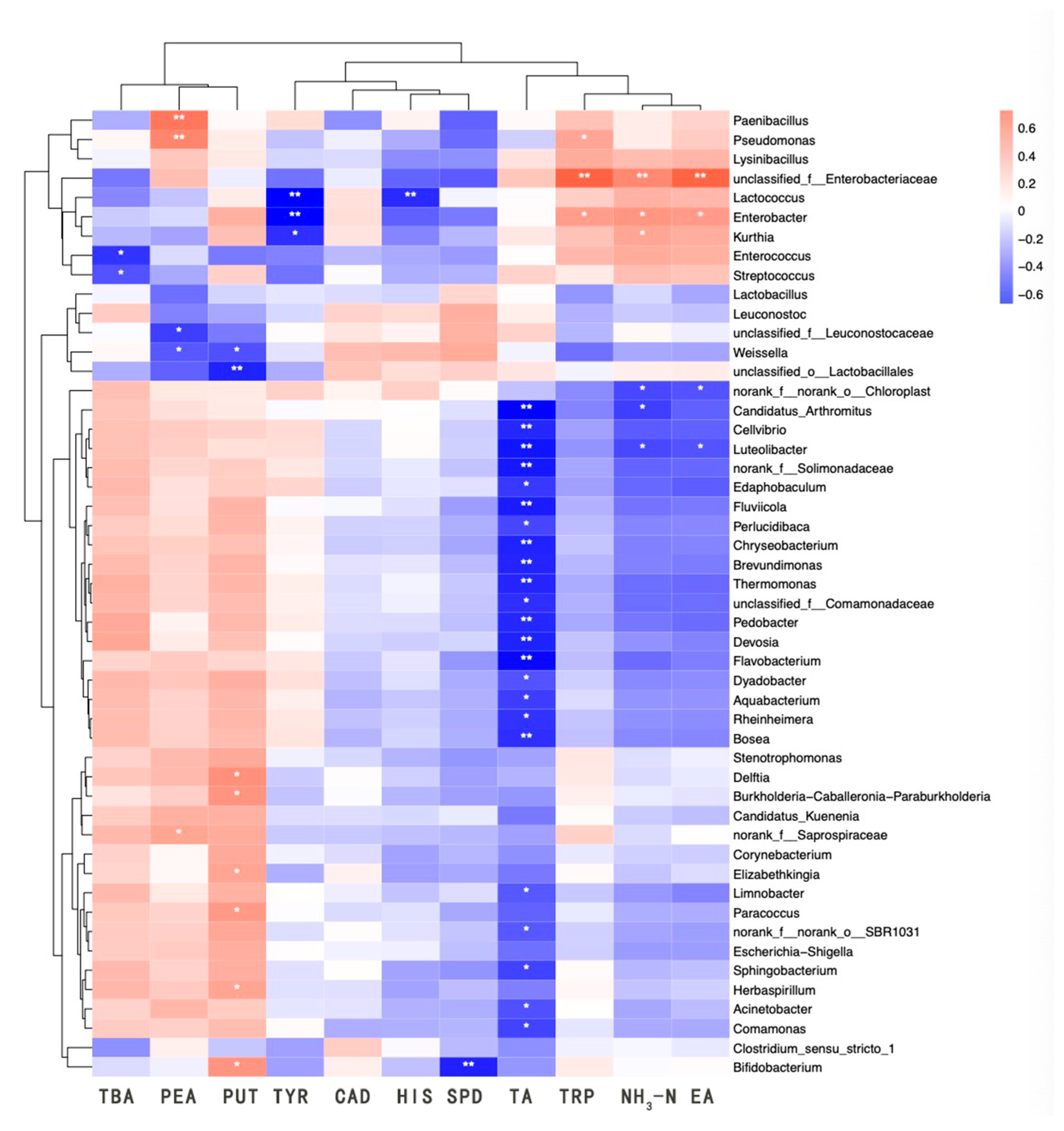
| Index | Tryptamine | 2-Phenylethylamine | Putrescine | Cadaverine | Histamine | Tyramine | Spermidine | Total BA | TA | NH3-N | EA |
|---|---|---|---|---|---|---|---|---|---|---|---|
| Tryptamine | 1 | 0.377 | 0.485 * | 0.438 * | −0.486 * | −0.482 * | −0.506 * | −0.349 | 0.198 | 0.737 ** | 0.857 ** |
| 2-Phenylethylamine | 1 | 0.142 | −0.354 | −0.319 | 0.016 | −0.343 | −0.225 | −0.272 | −0.078 | 0.162 | |
| Putrescine | 1 | −0.309 | −0.178 | −0.215 | −0.248 | −0.040 | 0.151 | 0.395 | 0.409 | ||
| Cadaverine | 1 | 0.864 ** | 0.179 | 0.767 ** | 0.746 ** | 0.530 * | 0.470 * | 0.467 * | |||
| Histamine | 1 | 0.486 * | 0.856 ** | 0.773 ** | 0.655 ** | 0.505 * | 0.500 ** | ||||
| Tyramine | 1 | 0.559 ** | 0.442 * | 0.076 | 0.561 ** | 0.563 ** | |||||
| Spermidine | 1 | 0.745 ** | 0.521 * | 0.427 * | 0.473 * | ||||||
| Total BA | 1 | 0.367 | 0.597 ** | 0.582 ** | |||||||
| TA | 1 | 0.250 | 0.274 | ||||||||
| NH3-N | 1 | 0.932 ** | |||||||||
| EA | 1 |
| Samples\Estimators | Ace | Chao | Shannon | Simpson |
|---|---|---|---|---|
| Q0 | 203.758 | 153.813 | 1.533 | 0.330 |
| Q1 | 41.881 | 40.250 | 0.553 | 0.765 |
| Q2 | 394.580 | 398.240 | 3.597 | 0.130 |
| Q3 | 286.834 | 286.324 | 2.001 | 0.285 |
| S1H1 | 574.101 | 588.071 | 4.209 | 0.077 |
| S1H2 | 388.527 | 390.500 | 4.112 | 0.036 |
| S1H3 | 435.946 | 439.125 | 4.457 | 0.040 |
| S1H5 | 346.094 | 343.875 | 2.440 | 0.274 |
| S1H10 | 416.670 | 421.848 | 3.944 | 0.054 |
| S1H20 | 125.908 | 100.000 | 1.890 | 0.316 |
| S2H1 | 173.680 | 137.353 | 2.323 | 0.163 |
| S2H2 | 476.776 | 479.531 | 4.414 | 0.034 |
| S2H3 | 519.401 | 520.520 | 3.698 | 0.079 |
| S2H5 | 642.061 | 638.676 | 2.948 | 0.091 |
| S2H10 | 910.278 | 910.357 | 4.162 | 0.051 |
| S2H20 | 255.716 | 257.000 | 2.701 | 0.145 |
| S3H1 | 309.180 | 325.125 | 2.740 | 0.161 |
| S3H2 | 313.308 | 315.000 | 3.479 | 0.071 |
| S3H3 | 289.938 | 305.000 | 2.331 | 0.231 |
| S3H5 | 74.647 | 73.667 | 2.320 | 0.171 |
| S3H10 | 76.739 | 83.000 | 2.031 | 0.247 |
| S3H20 | 106.012 | 103.500 | 2.222 | 0.229 |
Disclaimer/Publisher’s Note: The statements, opinions and data contained in all publications are solely those of the individual author(s) and contributor(s) and not of MDPI and/or the editor(s). MDPI and/or the editor(s) disclaim responsibility for any injury to people or property resulting from any ideas, methods, instructions or products referred to in the content. |
© 2025 by the authors. Licensee MDPI, Basel, Switzerland. This article is an open access article distributed under the terms and conditions of the Creative Commons Attribution (CC BY) license (https://creativecommons.org/licenses/by/4.0/).
Share and Cite
Guo, X.; Chen, K.; Chen, L.; Le, T.N.; Zhao, M.; Cai, H. Effects of Cold Post-Fermentation Process on Microbial Diversity and Biogenic Amines in Protease-Assisted Fermented sufu. Foods 2025, 14, 735. https://doi.org/10.3390/foods14050735
Guo X, Chen K, Chen L, Le TN, Zhao M, Cai H. Effects of Cold Post-Fermentation Process on Microbial Diversity and Biogenic Amines in Protease-Assisted Fermented sufu. Foods. 2025; 14(5):735. https://doi.org/10.3390/foods14050735
Chicago/Turabian StyleGuo, Xiaogang, Kaiyi Chen, Li Chen, Thanh Ninh Le, Minjie Zhao, and Haiying Cai. 2025. "Effects of Cold Post-Fermentation Process on Microbial Diversity and Biogenic Amines in Protease-Assisted Fermented sufu" Foods 14, no. 5: 735. https://doi.org/10.3390/foods14050735
APA StyleGuo, X., Chen, K., Chen, L., Le, T. N., Zhao, M., & Cai, H. (2025). Effects of Cold Post-Fermentation Process on Microbial Diversity and Biogenic Amines in Protease-Assisted Fermented sufu. Foods, 14(5), 735. https://doi.org/10.3390/foods14050735








